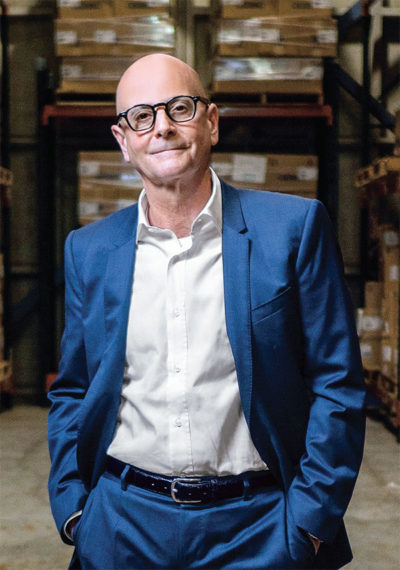
Photo: Angel Valentin
Felix Santos ’78, P’16, CEO of PRHS and Customed
In 2017, Hurricanes Irma and Maria devastated much of Puerto Rico. Access to basic medical supplies—syringes, tubes, catheters—was crucial.
During those difficult times, Puerto Rico Hospital Supply (PRHS) never closed, propelled by generators amid the destruction. Felix Santos ’78, P’16, is CEO of both PRHS and Customed, the company’s manufacturing arm.
His 250-person company has a vast reach, distributing goods to hospitals and doctors on the island as well as in Florida and the Caribbean, playing an essential role in health care throughout the region. The third-generation family business is the largest company of its kind in Puerto Rico, says Santos. “Puerto Rico is a big manufacturing place for medical devices,” he says. “We distribute everything but medicine and food.”
A native of Puerto Rico, Santos had known he wanted to go into business since he was a youth. Babson was his number-one choice of college, and he completed his degree in three years. “I was always an entrepreneurial person,” he says.
Santos began his career as a management consultant at Ernst & Young, focusing on health-care accounts. After earning an MBA from Northwestern University, he briefly worked on Wall Street before starting a wholesale flower business, Caribbean Cuts, also in New York City.
But Santos always knew that one day he would join his family’s business, which his grandfather founded in 1946. So in 1987, he moved back to Puerto Rico, became marketing director, and soon after came up with the plan to add the Customed division. “I saw a lot of potential to expand our business to other markets within health care outside of Puerto Rico,” he says, “and to develop our own private label, Customed, so we could start manufacturing our own products.” In 1991, the board named him CEO.
As the company grows to meet health-care demands, it retains the flavor of a family business. At 89, Santos’ father still keeps a hand in the company, and Santos works hard to provide customers with personalized service. “Babson was great for me, because it has such a large, international community of people with family-owned businesses,” he says.
His career, says Santos, is thrilling. “I love running my own show. I love the merchandising aspect and the marketing aspect. I travel worldwide looking for new products to develop or for us to distribute, in burgeoning areas like infection control and radiology,” he says.
Beyond his business, Santos also is using his expertise to help steer Puerto Rico’s beleaguered economy by serving on the official committee of unsecured creditors for the commonwealth, established as part of the Puerto Rico Oversight, Management, and Economic Stability Act, passed by Congress in 2016. The committee represents the interests of Puerto Rican general unsecured creditors, helping them to negotiate with debtors.
“It’s important to have a local businessperson that understands the challenges that Puerto Rican companies encounter on a daily basis,” he says. “We have all been severely affected by the downturn in the local economy, and the health-care sector is key to the financial recovery of the island.”—Kara Baskin
]]>
A Preventive Approach to Health »
After studying and working in the U.S. for eight years, Chinmoy Mishra, MBA’08, returned home to India in 2012 to address what he calls crucial public-health issues.

Prescribing with Precision »
Kristine Ashcraft, MBA’10, likes to employ the metaphor of a five-highway intersection when describing how Seattle-based YouScript helps deliver precision medicine.

Smooth Operations »
Operating rooms. Cadaver labs. An ever-changing surgery schedule. For Joanna Geisinger, MBA’17, these were part of everyday life as a surgical device representative.

A Way Out of the Dark »
Andres Martin’s cognitive decline “sprung out of nowhere” about five years ago when he was 17, says his older sister, Magala ’17. He gradually went from being a healthy teen to not speaking, not sleeping, and barely moving.
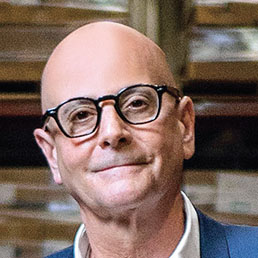
A Lifeline in Times of Trouble »
In 2017, Hurricanes Irma and Maria devastated much of Puerto Rico. Access to basic medical supplies was crucial. During those difficult times, Puerto Rico Hospital Supply, for which Felix Santos ’78, P’16, is CEO, never closed.
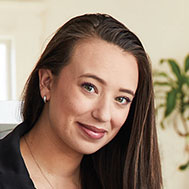
Help with Living a “Normal” Life »
One of the constant challenges of living with a long-term illness, such as Crohn’s disease, diabetes, or cancer, actually has nothing to do with what is happening inside the body, says Emily Levy ’16.
Dr. Mack Cheney certainly felt so, at least initially. He’s a co-founder of the Steven C. and Carmella R. Kletjian Foundation, which strives to improve the safety, affordability, and quality of surgery in the world’s poorest places. The work of the organization is vital. According to The Lancet Commission on Global Surgery, a staggering 5 billion people do not have access to safe and affordable surgical and anesthesia care.
Cheney co-founded the Kletjian Foundation with Carmella Kletjian, a member of Babson’s Board of Trustees, and she pushed for the Boston-based organization to work with the College. “It was very insightful and visionary that she took this approach. I didn’t understand it at first,” admits Cheney, a professor at Harvard Medical School. “I remember thinking, why would we partner with an entrepreneurial school?”
The unlikely partnership still puzzles many clinicians whom Cheney knows. “A lot of my surgical friends,” he says, “shake their heads and say, ‘Why would you do that?’” But setting up surgical care in a developing country is a complicated endeavor, requiring far more than medical expertise. Innovative approaches to business, leadership, and entrepreneurship also are necessities. With Babson’s expertise, the foundation aims to establish surgical care that is self-sufficient, sustainable, and not dependent on the outside help of clinician volunteers, who typically travel to developing countries to perform care but soon depart.
“We need more than the old way of parachuting in and then leaving,” says Kletjian. “It isn’t sustainable. We need to build an ecosystem. Having surgery, running hospitals—it’s a business. We need to teach others how to do it.”
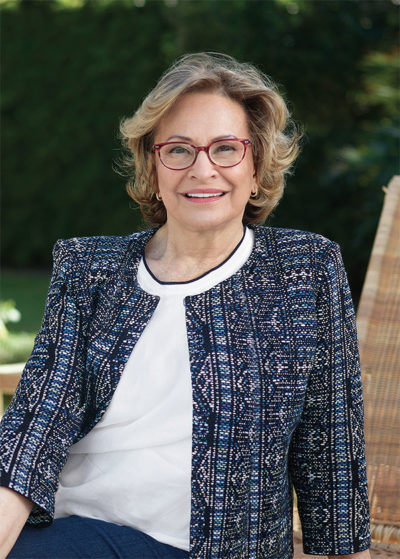
Photo: Jeffery Salter
Carmella Kletjian, Babson trustee and co-founder of the Steven C. and Carmella R. Kletjian Foundation
People Dying Unnecessarily
The Kletjian Foundation has made a significant investment in Babson. It not only has established an endowed Distinguished Professor in Global Surgery (a position it hopes will be filled this year), but also funded the Schlesinger Fund for Global Healthcare Entrepreneurship, a multifaceted initiative housed within The Lewis Institute that’s involved in research, student programs, and educational activities.
Kletjian long has known about the strengths of Babson. Her late husband, Steven Kletjian, attended the College, leaving before graduating to take over the family maintenance business after his father had passed away in 1969. Steven Kletjian grew that business, Unicco Facility Management, from about 55 employees when he took over to more than 18,000 when he sold the company in 2007. He passed away that same year.
Carmella Kletjian started the foundation in 2012 with Cheney and John Freeman, the former president and managing director of investment firm Quabbin Capital. Kletjian’s interest in medicine stems from her 30-year career as a surgical nurse anesthetist. “I was a nurse for most of my life,” she says. Through her work, she met Cheney and other clinicians who went on medical missions and soon came to realize what a tremendous unmet need exists for surgical care around the world. “You go in some countries, and they have to walk miles to get care,” Kletjian says.
In his 30 years of delivering care in developing countries such as Guatemala, Haiti, Ecuador, and Kenya, Cheney has seen this need firsthand. “People are dying unnecessarily,” says the otolaryngologist. “People are dying of benign disease.” Basic surgical care could make a major difference. A patient in a developing country may have a benign growth on his face, for instance, that he can’t have removed because there are no surgeons in the area. “When the lesion is neglected, it becomes life-threatening,” Cheney says. “If the same patient had lived in Boston, it would have been a small growth an oral surgeon would have removed.” Cesarean sections are another example of commonplace procedures that are desperately needed in some developing countries. “The mortality rate during childbirth in many developing countries is staggering,” Cheney says. “If C-sections are available, mortality rates for both mother and child go down.”
The Kletjian Foundation offers surgical training to local clinicians, but performing surgery in these poor places is much more complicated than, say, running a health clinic that gives vaccinations. “You can run that out of a garage if you have the vaccines,” Cheney says. Surgeons in a developing country are confronted with questions such as does the facility have reliable electricity and clean water? Do the instruments work? Does it have a steady supply of oxygen? Clinicians also must consider what kind of access to care their patients have, how they will pay for services, and if they have insurance.
For help addressing core questions of infrastructure, supplies, and access—the very issues that will determine whether surgical care in a developing country remains sustainable—the Kletjian Foundation has turned to Babson. Although the foundation has a number of partner institutions, including Harvard Medical School, Boston-based teaching hospitals, and the World Health Organization, the group’s only nonmedical affiliate is the College. The foundation encourages its partners to meet and collaborate, and Babson brings a pivotal business and entrepreneurial point of view. “If we just had a room full of surgeons, there would be very little divergence of opinion,” Cheney says.
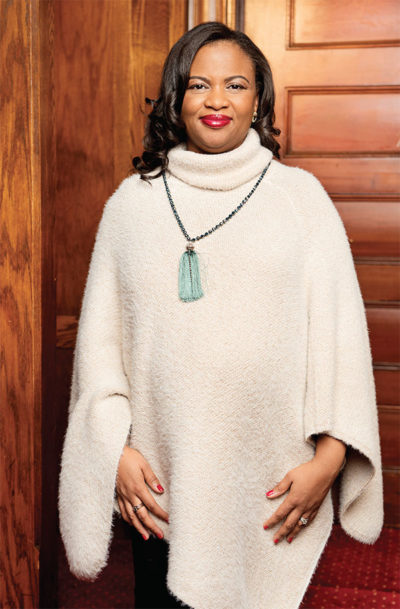
Photo: Webb Chappell
Wiljeana Glover, faculty director of the Schlesinger Fund for Global Healthcare Entrepreneurship
Babson’s Role
To understand more fully how Babson is having an impact on medical care, consider the work of the Schlesinger Fund for Global Healthcare Entrepreneurship. Supported by the Kletjian Foundation and named after former Babson President Len Schlesinger, the fund was founded in 2013 and since then has organized a number of programs that, at their heart, explore the role of entrepreneurship in global health.
Providing study-abroad opportunities for Babson students is one of its objectives, says Wiljeana Glover, faculty director for the Schlesinger Fund. For example, a fellowship has sent MBA students to Uganda to help in an accelerator focused on medical devices and technology. Teams in the accelerator are developing a variety of helpful products, from a locally produced hand sanitizer to a telehealth platform offering support for midwives by connecting them with doctors. “We’ve been able to infuse ET&A thinking into the way they’re approaching things,” says Glover, an assistant professor of technology and operations management.
The Schlesinger Fund also brings experts and entrepreneurs to campus for its Disrupting Global Health Seminar Series. One memorable session, says Glover, involved Dr. Mahmoud Hariri, a surgeon from war-torn Syria. “He was talking about how they’re taking care of people in the middle of a war, and how they’ve created hospitals underground,” Glover says. Case studies and research are another priority of the Schlesinger Fund. One of its cases examined how a doctor working in Uganda was able to develop an alternative, low-cost treatment for hydrocephalus (sometimes called “water on the brain”). Another case study in Uganda looked at how a hospital was implementing an electronic database of patient information that potentially could be rolled out to low-resource areas across the country.
Glover found the innovative and entrepreneurial actions of the clinicians in these cases to be striking. “Some of the doctors might have been creating new products; others might have been creating new processes. They taught us a lot about seeing entrepreneurial leadership in places we weren’t necessarily expecting it,” she says. “Very few, if any of the cases, were driven by folks with MBAs. These are clinicians who have just figured this out on the ground.”
Glover wonders what could be achieved if more clinicians, especially those in the developing world, were exposed to these sorts of skills. If doctors were trained regularly in entrepreneurship, leadership, and business, could they accomplish even more innovation? “If this is what it takes to move the needle on global surgery and global health, then how do we train people in this?” Glover says. “We have to think about workforce training beyond surgical skills. If we’re going to be innovative, we need to think about entrepreneurial opportunities. Surgeons will have to create new models of care. They’ll have to open up their own clinics. They’ll have to develop some new product or service.”
The Schlesinger Fund will begin to test the possibilities of entrepreneurial training. A program focused on Haiti that’s currently in the planning stages will provide education for doctors and other stakeholders such as insurers and suppliers. Glover says the country already has many clinicians who improvise and innovate, but this program, with training sessions to be held potentially at Babson and in Haiti, is designed to amplify those actions. “We’re coming in and saying, how can we make that systemic?” she says. “How do we build that into the way that we’re thinking about medical training?”
With Babson providing valuable expertise, the Kletjian Foundation’s ultimate goal is sustainability. It has worked in Uganda, Haiti, and Ecuador and is looking at Peru in the future, but eventually the foundation expects its help won’t be needed in any of these places. As Cheney says, “We’ll just be sending holiday cards back and forth.”
The implications of such sustainability could be far-reaching, notes Kletjian. Surgical facilities that are sound and safe will bring not only better health outcomes but also much-needed jobs, from doctors and nurses to lab technicians to administrative assistants and more. “Ideally, we’re building an economic engine,” Kletjian says. “I get very excited about this.”
]]>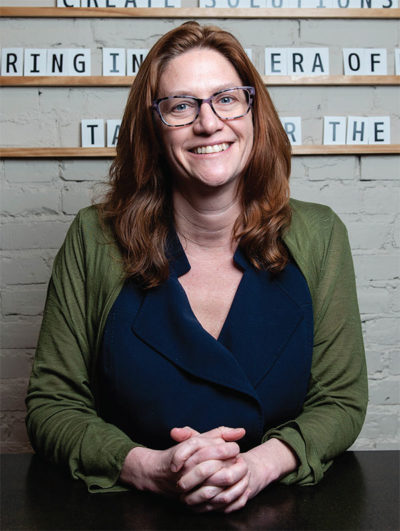
Photo: Chona Kasinger
Kristine Ashcraft, MBA’10, CEO of YouScript
Kristine Ashcraft, MBA’10, likes to employ the metaphor of a five-highway intersection when describing how Seattle-based YouScript helps deliver precision medicine.
“Most of the time,” says Ashcraft, CEO of YouScript, “when we take medications, they are processed by five main enzymes of the liver.” Think of these enzymes like highways, she says. Traditionally, doctors have prescribed medicine as though each highway functions identically in every patient. But genetic variations, other drugs, over-the-counter substances, and diet can block roads, close lanes, or create detours.
“YouScript predicts metabolic traffic jams,” says Ashcraft. Its software flags patients at risk of gene-based adverse drug reactions. Testing for relevant genetic variations is completed by partnered labs, and the secured information is used by electronic medical records and pharmacy software systems to avert adverse drug interactions. Competing programs might perform a simple “yes-no” version of predicting bad drug interactions, but YouScript, says Ashcraft, is unique in moving “beyond the binary,” assessing multiple variables at once.
She sees YouScript as well positioned to ride the wave that some view as health care’s future—precision medicine, the science of targeting treatments to specific patients and tailoring medical decisions, prescriptions, and products to individual needs. It’s an emerging field made possible by advances in genetic testing and other diagnostic and predictive tools.
When precision medicine began to gain momentum, Ashcraft already had spent years working in genetic testing. She earned her undergraduate degree in molecular biology but soon realized that lab work was not for her. Instead, she went into sales; when she heard of a position at a genetic testing lab, she thought it would be a good way to utilize her degree. She joined Genelex in 2000, eventually becoming CEO. Genelex was founded as a forensic crime lab but, seeking ways to leverage its technology, branched into broader testing and in 2016 spun off YouScript. Along the way, Ashcraft earned her Babson MBA in a program then based in Portland, Oregon. The experience, she says, was invaluable. “We’ve raised $8.6 million to date, and I couldn’t have done that without my Babson education.”
Ashcraft waxes enthusiastic when she talks numbers, describing how studies have shown that YouScript can result in a 52 percent drop in hospital readmissions, an 85 percent drop in patient deaths due to medication mishaps, and a savings of more than $4,000 per patient in 60 days. But she’s positively impassioned when it comes to putting a human face on what YouScript can accomplish. She tells the stories of Elise, whose Alzheimer’s-like symptoms resolved when genetic testing led to a change in her medication, and, on the flip side, of Michael, a child who died from an overdose because he had an undetected genetic variation.
The work, Ashcraft admits, can be frustrating. “Only crazy people go into health care,” she says with a laugh. “The economics are frankly broken, and it’s a long haul.”
But the lofty goal and the urgent need keep her focused. “We’re going to fix medication management,” she says. “Stay tuned.”—Jane Dornbusch
]]>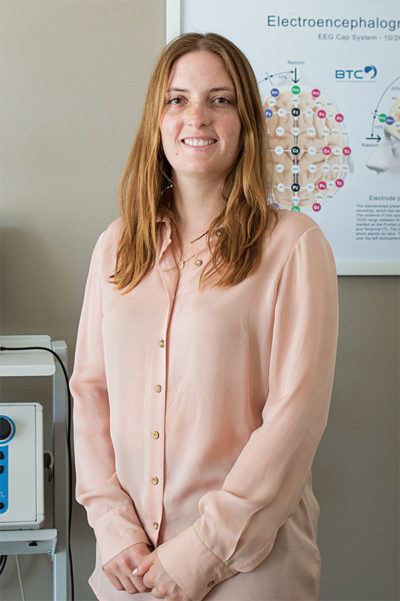
Photo: Alicia Vera
Magala Martin ’17 at the Brain Treatment Center in Monterrey, Mexico
Andres Martin’s cognitive decline “sprung out of nowhere” about five years ago when he was 17, says his older sister, Magala ’17. He gradually went from being a healthy teen to not speaking, not sleeping, and barely moving.
“He had what they call a cognitive collapse,” says Pedro Martin, the oldest of the three Martin siblings. “The front part of his brain stopped working efficiently.” The Martins, including father Pedro, a Global Advisory Board member, and mother Magala, live in Mexico, but for months the family traveled around the U.S. in search of a treatment. They tried well-known hospitals on the East Coast, but nothing seemed to work. Eventually, a doctor recommended the Brain Treatment Center (BTC) in Newport Beach, California.
Affiliated with the USC Neurorestoration Center, the BTC developed what it calls Magnetic e-Resonance Therapy, an individualized, noninvasive treatment that aims to help the brain’s communication networks function better, potentially providing a number of health benefits, from better sleep to reduced stress to clearer thinking and more. The parents met with the founder, Dr. Yi Jin, and decided to give the treatment a try. “My brother hadn’t slept in three weeks,” says Magala. “After the first treatment, he slept for 12 hours.”
For about nine months, Andres received treatments, and he steadily improved. “He started to speak again. I hadn’t spoken to my brother in four months. It was a huge step,” says Magala. “He started to eat again. Then he started making sentences, and he started realizing what had happened. Now he speaks perfectly.” Brother Pedro notes that some of Andres’ cognitive functions could still improve. “But before and after treatment, he is completely different,” he says.
The family was so impressed with the improvements in Andres that they talked with Jin about opening a facility in Mexico. Magala, then a second-year student, put together a business plan with the help of her Babson professors, and in the summer of 2014, her parents presented to the BTC board. “They loved it, and we bought a license,” she says.
Magala wanted to help the family launch its venture. So instead of heading back for her junior year, she took a year off to work with her brother, Pedro, and mother to set up operations. In the fall of 2014, the Martins opened a BTC in Mexico City, followed by another in Monterrey.
Currently, Pedro runs both BTCs along with their mother, who serves as CEO. Magala helps with finances but has taken a full-time job with Tim Hortons, the Canadian restaurant chain. “It’s my ultimate goal to go back. I just thought that I needed a better foundation,” she says. “Working with my family, we have a good relationship. It’s also very heartwarming to be a part of this.”
Pedro, too, draws satisfaction from helping others. “When you are dealing with neurological illness, it feels like you are in a very dark room, for the person and the family,” he says. “We want to be an important part of Mexico’s mental-health industry. We did this because we know how it feels to be in that dark room. And this is a light that helps you find a way out.”—Donna Coco
]]>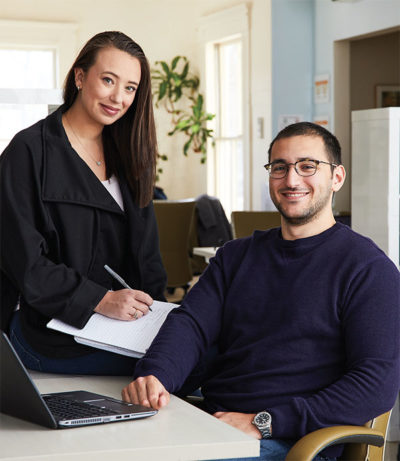
Photo: Pat Piasecki
Emily Levy ’16 and Yousef Al-Humaidhi ’15, co-founders of Mighty Well
One of the constant challenges of living with a long-term illness, such as Crohn’s disease, diabetes, or cancer, actually has nothing to do with what is happening inside the body, says Emily Levy ’16. It’s the struggle to look beyond the unwelcome reminders of an illness and prioritize what makes people feel “normal” and well.
Levy would know. She had a PICC line, used for delivery of intravenous medicine needed to treat her chronic neurological Lyme disease. Diagnosed during her second year at Babson, her illness derailed any hopes of studying abroad at the time. Instead, Levy went west for spring semester, taking part in Babson’s San Francisco program. She took a class taught by Bigbelly founder Jim Poss, MBA’03, in which students had to create a business. Levy and classmate Maria del Mar Gomez ’16 used the course to refine an idea for stylish and functional PICC line protectors that they had begun prototyping several months earlier. “PICC line protectors on the market at the time were ugly,” says Levy, “and if it looked good, it didn’t function well.”
What started as just one product has grown into Mighty Well, a full-time startup for which Levy is CEO. Together with del Mar Gomez and co-founder and CFO Yousef Al-Humaidhi ’15, Levy is on a mission to make Mighty Well the Under Armour of the health-care industry. It now sells a variety of PICC line covers, T-shirts, and other items (right, Levy is wearing the Mighty Wrap) for those with chronic conditions. “Larger fashion brands have ignored this population,” says Al-Humaidhi. “Now, people are so much more open to patients and consumers. We’re pulling from what’s been done both in health care and athletic apparel to create a new segment of the market.”
Mighty Well isn’t stopping at medical apparel. “We know our audience is starved for content that goes beyond what they’re reading on WebMD,” says Levy, who recognizes that managing a diagnosis and adjusting to a new normal can be confusing. Ongoing conversations with patients led her to focus on growing Mighty Well’s digital presence as well, curating patient and caregiver stories and hiring team members who can help bring this digital vision to life.
As the company grows, Levy is leading fundraising for its seed round and already has garnered funding from Breakaway Ventures and a personal investment from Tim Draper of Draper Associates. “We’ve been motivated to help as many people as possible since the beginning, and we knew we’d need external capital to do that,” she says. “Babson and the WIN Lab especially have been instrumental in giving us connections and opening doors along the way.”
With all of Mighty Well’s success, Levy hasn’t lost sight of how she started. “In some ways, I’m still a professional patient,” she says, and she appreciates the window into her customers’ lives. “It feels great when I’m at the hospital for meetings and see people who are visibly better off by wearing our products. Even better is seeing people go from chemo to Starbucks without anybody knowing they’re a patient.”—Elizabeth Atwater
]]>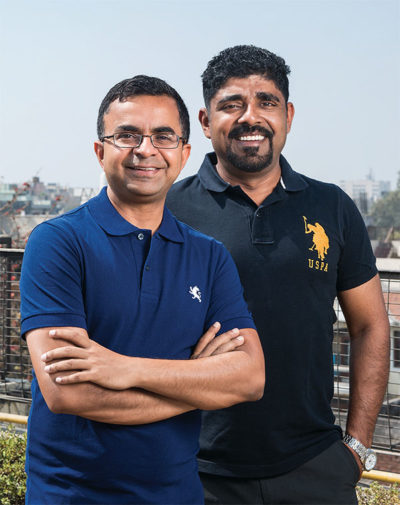
Photo: Reuben Singh
Chinmoy Mishra, MBA’08 (left), and Dhairya Gupta, MBA’08, co-founders of AllizHealth
After studying and working in the U.S. for eight years, Chinmoy Mishra, MBA’08, returned home to India in 2012 to address what he calls crucial public-health issues. The country is dealing with an epidemic of “lifestyle-related diseases,” he says, such as hypertension and diabetes.
Part of the problem, he believes, is a lack of preventive medicine. So Mishra launched AllizHealth, a software platform that helps users track, manage, and improve their health. It offers myriad features, from allowing users to digitize their health records to offering targeted wellness programs to sending appointment and medication reminders and more. A mobile app gives users easy access to the data.
The product identifies a person’s risk of disease using various medical models recommended by the World Health Organization, says Mishra. Based on years of population- and ethnicity-based research, these models provide ways to calculate individual risk for lifestyle-related diseases. AllizHealth also has a medical advisory panel, composed of physicians from the Mayo Clinic and the All India Institute of Medical Sciences, who help evaluate the models and validate recommendations produced by its risk-calculation engine. “Our system starts interacting with users in a personalized way based on risk,” Mishra says. “If I’m identified as high risk for diabetes, for example, I’ll get related health tips and reminders.”
Leveraging a background in health-care marketing and sales, Mishra formed the business with his sister, Rasmi Mishra, who holds a doctorate in neural networks. He also works alongside classmate and co-founder Dhairya Gupta, MBA’08. Lessons learned at Babson helped them launch the startup in a challenging market. “Preventive care is yet to be popular in a market that primarily operates as a curative care model,” Mishra says.
So far, though, AllizHealth is doing well. In 2013, it started with just four employees, breaking into the industry by working with schools to digitize students’ health data. This year, the 30-person company is projected to have 1 million users, and Mishra plans to expand to other countries, including Malaysia, Indonesia, the Philippines, and Vietnam. More than 40 companies in India now use AllizHealth as part of their health and wellness initiatives. Employers like the platform, says Mishra, because by improving the health of employees they also can improve productivity and reduce absenteeism. Companies can build targeted wellness programs, such as exercise or smoking cessation, based on AllizHealth data, he adds. “We were in the right place at the right time,” Mishra says. “Many insurance providers and corporations were looking for a platform like ours.”
While launching a startup is never simple, Mishra believes in his company’s mission and hopes the platform will empower users to manage their health. “The ability to have provided even a single individual with the help they needed,” he says, “makes up for all the startup struggles we have to go through.”—Kara Baskin
]]>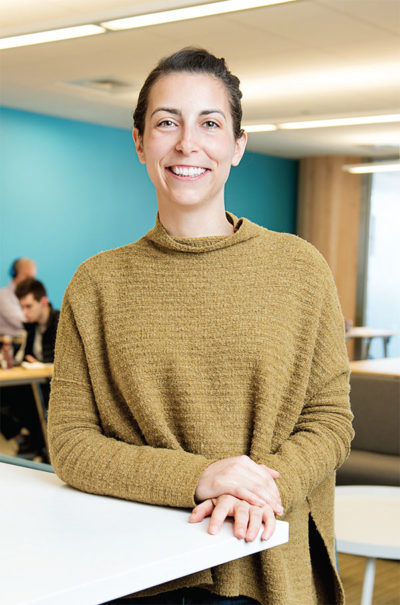
Photo: Webb Chappell
Joanna Geisinger, MBA’17, founder, TORq Interface
Operating rooms. Cadaver labs. An ever-changing surgery schedule. For Joanna Geisinger, MBA’17, these were part of everyday life as a surgical device representative.
During her six-year career in that industry, Geisinger experienced firsthand the thrills and disappointments of working in health care. Contributing to successful joint replacements and life-changing surgeries made Geisinger feel like she was making an impact in patients’ lives, yet she was frustrated by inefficiencies in the system. A typical day could include waiting hours for a delayed procedure to begin or commuting between hospitals only to discover an operation had been canceled.
The more Geisinger talked with colleagues, the more convinced she became that these inefficiencies could be fixed. “Everyone I worked with agreed that it was a big problem,” she says. So Geisinger began thinking about ways to improve the process and formulating an idea for a startup. As she worked, she continued to check in with colleagues. “I wanted to make sure I wasn’t just solving something for myself,” she says, “but that I was solving a real problem in the market.”
In 2015, Geisinger came to Babson with the idea for TORq Interface, a HIPAA-compliant platform that streamlines surgical scheduling. “I wasn’t just trying to get an MBA,” she says. “I specifically came to Babson to launch my company.”
In the U.S., the medical-device supply chain reportedly generates $5 billion in waste each year. TORq’s mission is to minimize inefficiencies by connecting medical-device representatives with hospitals’ surgical planning networks. By automating these communications, the platform could save all involved—including patients—time and money. For example, TORq allows surgical schedules to be shared as many as four weeks in advance, instead of the more typical five days, and they update in real time to reflect the fluid schedules inside a hospital OR.
Currently, TORq is undergoing pilot tests with three Boston-area hospitals, with a fourth starting later this year. Geisinger is hoping for an official launch this fall. As work on TORq progresses, she keeps lessons from her MBA classes in mind. “Babson taught me that it’s not about one idea being better than another,” she says, “but instead about which idea has the best business model and execution.” Geisinger also learned the importance of customer feedback and has updated TORq’s technology using input from the pilot tests.
She is confident that her time in the field will give TORq an edge in the marketplace, but she never underestimates the challenge of innovating within the boundaries of the health-care system. “Health care can be unique in its resistance to change,” she says, “because the stakes are just so high.”
Still, Geisinger is cautiously optimistic about the launch. “Last year, I didn’t know what the customer reaction would be, and I was just praying that a hospital would get on board,” she says. “Now, we’re working with great hospitals, and things feel like they’re starting to come together. It’s a really fun stage for the company.”—Elizabeth Atwater, senior manager, thought leadership content
]]>Clearly, the system could use a healthy dose of innovation, the kind entrepreneurs are poised to provide. For example, in a bold move, Berkshire Hathaway, Amazon, and JPMorgan Chase recently announced a partnership to launch an independent health-care company for their employees. In the announcement, billionaire entrepreneur Warren Buffett said: “The ballooning costs of health care act as a hungry tapeworm on the American economy.”
Babson-educated physicians agree that entrepreneurial steps are needed. Despite their varying specialties and professional goals, these doctors believe their entrepreneurial training gives them an edge. “If long-established companies don’t continue to evolve, then we will see others coming into this industry and disrupting it,” says Dr. Carolyn Langer, former chief medical officer for MassHealth, the Massachusetts Medicaid program, and a current Evening MBA student.
Doctors need to consider how they compete in their own industry, adds Dr. Renee Edwards, MBA’10, vice president, chief medical officer of Oregon Health & Science University (OHSU) HealthCare in Portland, Oregon. “I believe doctors have to be at the forefront of that conversation.”
Beyond Medical Knowledge
Edwards, a urogynecologist who specializes in pelvic reconstructive surgery for women, moved to OHSU after completing her medical education, residency, and fellowship in Chicago. In 2000, after just one year, she became medical director of its Center for Women’s Health, which Edwards says took a multidisciplinary approach to care long before this was common. “Health care tends to be highly siloed,” Edwards says, but patients don’t think that way. “More and more, medicine is saying, ‘How do we create an experience for the patient that’s basically one-stop shopping?’”
Although Edwards initially felt drawn to medicine to help people, she also found herself engaged by the systems that are an integral part of health care. “I’ve always been interested in considering how all the pieces are interconnected, how we deliver our product and work to improve it, for both the patient and the people working in the system,” she says. But she saw gaps in her business knowledge and so decided to pursue an MBA through Babson’s West Coast program, located at the time in Portland, Oregon. “I needed to look outside traditional medical thinking,” Edwards says.
She loved interacting with fellow students from such industries as technology, retail, and film. “It taught me to think beyond my own knowledge base, to think intentionally about who else I needed on my team,” she says. “In the eight years since I completed my MBA, medicine has become much more about how we work in teams, how we build these multidisciplinary models.”
Edwards believes her time at Babson prepared her for this shift, leading to her recent promotion to chief medical officer. “The more doctors understand the business of medicine, the more they appreciate the pressures that are being applied in health care today,” Edwards says. “Unless we understand those pressures, we cannot be articulate in the discussion.”
Speaking the Same Language
Dr. Art Mourtzinos, MBA’12, was thinking in business terms long before he treated his first patient. A child of Greek immigrants, Mourtzinos grew up in Lowell, Massachusetts, where his family owned a pizza shop. He had an aptitude for math, and his father spoke very little English, so from an early age Mourtzinos helped run the restaurant and then other family endeavors. But his father also urged his ambitious son to broaden his vision for a career.
During high school, Mourtzinos volunteered at a hospital, restocking shelves in the operating room where he watched surgeries unfold on video screens. “I fell in love with surgery,” he says. After high school, he entered an accelerated seven-year program at Boston University, which combined pre-med with medical school. Mourtzinos considered adding an MBA to his course load but ultimately opted out, feeling that med school was challenging enough. He trained as a urologist, completed a fellowship at UCLA in pelvic reconstructive surgery for men and women, and in 2006 came to the Lahey Clinic (now the Lahey Hospital & Medical Center) in Burlington, Massachusetts. Today he is director of the Lahey’s Continence Center, where he maintains a busy practice performing surgeries to correct incontinence, with a special focus on men whose incontinence is the result of cancer therapy and women with continence problems after childbirth.
Despite his intense schedule, Mourtzinos continued to consider an MBA. He had his eye on roles in hospital administration and saw a deeper understanding of business as an advantage, given that many colleagues seemed to lack basic business knowledge. It’s somewhat understandable, Mourtzinos says. “Nobody teaches you those things in medical school because you’re so focused on medicine, on trying to do what’s right for your patients,” he says.
But his ambivalence about earning an MBA wasn’t only an issue of time or energy; Mourtzinos also sensed a bias among some physicians against people with business expertise. He spoke to one hospital administrator, now elsewhere, about his desire to pursue an MBA. “He did not have an MBA himself and wasn’t very supportive,” Mourtzinos says.
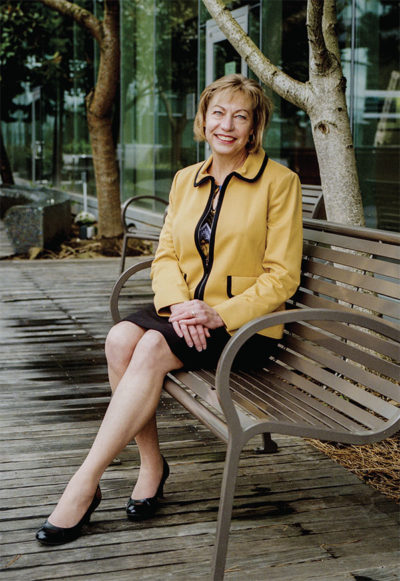
Photo: Isaac Lane Koval
Dr. Renee Edwards, MBA’10, vice president, chief medical officer of Oregon Health & Science University HealthCare
More recently, however, Mourtzinos has seen that distrust fade. A new CEO arrived and encouraged Mourtzinos to go after his interest. After earning his Babson MBA, Mourtzinos joined the hospital’s board of trustees and became vice chairman of its physician compensation plan. In much the same way that many doctors don’t know how to read balance sheets or income statements, Mourtzinos notes there’s a lack of medical knowledge among economists and others who work in health-care policy. “Individuals like myself can bridge this gap,” he says. “We can relate to both sides of the equation by communicating with all parties in a language everyone can understand.”
In that vein, Edwards of OHSU spends about 20 percent of her week in clinic, in part to keep her surgical skills sharp. But she also feels obligated to understand medicine from the inside. “How can I be involved in the work of designing a system, looking for performance improvement opportunities, asking providers to do certain things, unless I am also embedded in that work?” she asks.
Alternative Models for Primary Care
One trend in health care involves shifting from a fee-for-service model, which pays doctors per patient visit, to a value-based care model, which pays doctors based on patients’ outcomes. Insurers reward doctors for reducing avoidable hospital admissions for patients with chronic conditions, such as diabetes or cardiovascular disease. This requires doctors and their teams to be more proactive and focus on care coordination and preventive measures, explains Langer. Providers might check in with patients regularly with the goal of intervening if needed before patients become too sick.
That kind of preventive care appeals to Dr. Scott Early, a current Evening MBA student. A primary care physician in Lawrence, Massachusetts, Early worked for many years at community health centers, helping set up programs intended to improve the health of their mostly low-income patients. At the Greater Lawrence Family Health Center, for example, he established the nation’s first residency program sponsored directly by a community health center. It trained young doctors in community health practice and gave the center the resources to expand patient services such as prenatal care. Early says the city experienced a drop in infant mortality in the 1990s, from 17 deaths per 1,000 live births to eight per 1,000, in part because it was easier for pregnant women to see a provider.
He moved to what is now known as Steward Health Care, where he was vice president of family medicine, and then assumed the chief medical officer role at Lynn Community Health Center (LCHC). In both places, he thought about ways to transform the primary care model but found change to be difficult. “I remember endless faculty conversations about how to teach our residents to take care of really sick and complicated patients in 15- or 20-minute visits,” Early says. “Ultimately, I concluded that it wasn’t possible. Good care takes time. Trying to do the impossible was just burning out the amazing faculty and residents we had attracted.”
In 2015, he left LCHC, began his MBA at Babson, and opened his own practice, Kronos Health, in Lawrence. The central idea at Kronos is that spending more on primary care—hiring more practitioners and giving them more time with their patients—ultimately saves money. The U.S. spends an estimated 5 to 6 percent of health-care dollars on primary care. But Early believes that if insurers doubled that amount to 12 percent, patients could receive more attentive care and need fewer costly interventions. He believes this approach also could prune waste. Early quotes an analysis by the Rand Corp., which found that 18 to 37 percent of every dollar spent on health care goes to unnecessary tests and treatments. But when doctors know their patients well and see them often, Early says, these missteps can be more easily avoided, and patients are less likely to need costly emergency department visits or hospital stays.
Today, most full-time primary care doctors have 1,500 to 3,000 patients and see three to four patients an hour, Early says, a dizzying pace that allows little time to discuss complex health problems. After modeling his theory, Early believes his practice would work best with just 700 patients for each physician, allowing 30 to 60 minutes for each visit. But so far, he hasn’t been able to fully implement this vision. Current models, even those that reward doctors for healthy patients, don’t yet pay enough to fund this type of practice. “So far my wife and I have completely bootstrapped this,” Early says. “We are now breaking even, but without me taking a salary.”
Early has visited insurance companies to discuss new payment models, asking that they invest upfront in the potential savings realized from better care. The companies are intrigued but say his practice is too small, asking that he return when the practice is much larger. “It’s a chicken-and-egg dilemma,” he says, “which is why I’ve concluded that we need venture capital backing to grow.” He says that with a “modest” amount of venture capital he could hire additional staff and purchase practices from retiring physicians. “We could get big enough to attract the interest of some of the insurers,” he says, adding that he has been closely watching Iora Health, a Boston-based health-care company with a similar model that launched with venture capital.
Patients and insurers wouldn’t be the only ones to benefit, Early says; doctors would, too. As it stands now, typical primary care medicine is nicknamed “the hamster wheel.” “Providers are running faster and faster and not getting anywhere,” Early says. “Burnout in primary care is rampant.” As a result, a shrinking number of medical students choose primary care. But Early hopes organizations offering saner schedules and the satisfaction of providing stellar care will attract more young doctors back to the field.
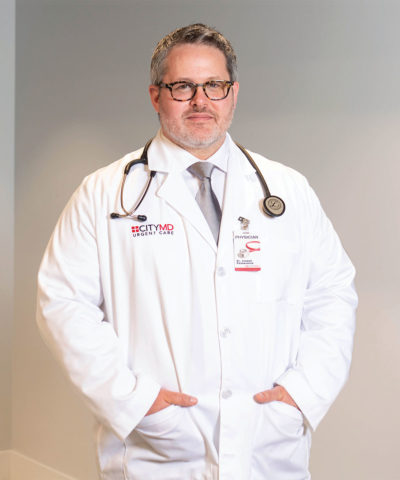
Photo: Chona Kasinger
Dr. Joe Passanante ’91, senior vice president of medical operations, Northwest region, CityMD
Doctor-Patient Connections
Dr. Joe Passanante ’91 saw similar frustration and burnout among emergency-room physicians after working for more than a decade in emergency medicine in the U.S. and China. “I love the adrenaline rush of the ER and being ready for any type of emergency, but there is a point when the night shifts take a toll, and dealing with the human condition in extreme situations takes a toll,” he says.
After seven years in China, Passanante was attending a medical conference in the U.S. when he met a group of ER physicians who seemed unusually enthusiastic about their work. He learned that they had launched an urgent-care company, CityMD, that aimed to provide excellent customer service while fostering a company culture of kindness. After shadowing a CityMD doctor in New York City, Passanante was impressed and joined the staff in December 2013. Since then Passanante has become partner and senior vice president of medical operations, Northwest region; he is based in Seattle, where he has opened five sites in the past two years.
CityMD has 100 sites in the U.S. and competes both with ERs and other urgent-care companies. Feedback from its patients often highlights the speed and quality of care, Passanante says. The average wait time at its facilities is eight minutes for walk-in visits, well below that of most ERs. “Emergency departments have specific triage protocols that place the least urgent cases at the back of the line,” Passanante says. “It’s commonplace for a patient to wait two-plus hours to have their urinary tract infection treated.”
He believes CityMD’s operating model helps keep patients and staff happy. For example, the company hires medical scribes to accompany doctors as they see patients. The scribes take notes and enter all information into the computer system, saving doctors time and allowing them to connect more easily with patients during visits, Passanante explains. A dedicated aftercare team works to get test results to patients and to schedule follow-up care. An emphasis at CityMD on hiring employees who value kindness contributes to a pleasant atmosphere. “When kindness is a shared goal,” says Passanante, “it’s easy for the team to row in the same direction.”
In Oregon, Edwards also is thinking entrepreneurially about ways to improve patient care while holding the line on costs. Next spring, OHSU plans to open a new building devoted largely to surgical care. Increasingly, surgeries have become minimally invasive, notes Edwards, which means less patient recovery time and trimmed coverage from insurance companies. So the new building was designed to move these patients quickly and safely through their procedures and into recovery with fewer staff members. “I created a multidisciplinary team charged with ‘modeling’ this new care concept using an existing floor of our current hospital,” Edwards says, giving the surgery team a place to experiment with different patient-flow and nursing-care routines and time to perfect them before the move.
Much of Edwards’ work as a health-care administrator has been about dismantling the silos common in medicine. This was particularly difficult early in her career at OHSU as she helped expand the Center for Women’s Health, where specialists from many departments worked together. “We struggled a lot because finances follow departments,” she says, and departments were not always willing to share revenue across the multidisciplinary center. “We created new financial and practice models that allowed multiple specialties to work together more efficiently,” Edwards says, though she acknowledges that departments still wrestle with these questions.
“Doctors are not generally encouraged to stray from ‘the way something should be done,’” Edwards says. “We are taught to follow standard protocols. An entrepreneurial education challenges a physician to think differently, to break out of the mindset of following set rules and consider alternate paths.”
Edwards remembers a big shift in her own thinking during her MBA coursework, when she began to consider a new marketing and communications strategy for the Center for Women’s Health that emphasized social media. “We hired a communications person and worked to develop as many direct-to-consumer venues as we could,” Edwards says. She even opened her own Twitter account to address hot medical topics. In the staid world of academic medical centers, she says, these steps stood out.
The Entrepreneurial Difference
Other Babson-educated physicians say they view problems and solutions differently as well. Passanante didn’t take a standard path into medicine or to his current role with CityMD. He admits that after graduating from Babson he was somewhat “rudderless,” drifting without passion between jobs for a few years until he read a 1993 Chicago Tribune profile of a pediatric plastic surgeon. “I thought ‘Wow! That sounds significant.’ I just couldn’t think of a better career than helping babies with birth defects,” he says.
Passanante made an appointment with the dean of the medical school at Northwestern University in Chicago to ask about requirements for admission. “He did his best to talk me out of it,” Passanante says. “But I was absolutely not going to take no for an answer.” So the dean recommended that he take some college-level science courses and find ways to learn more about medicine. Passanante took the classes and became an EMT and a paramedic. He then worked as a lab tech for a DNA researcher and in the Cook County morgue, assisting with autopsies. Meanwhile, he continued to check in with the dean at Northwestern, who eventually gave him the green light to apply. Passanante was accepted and began medical school in the fall of 1998, later opting for a residency in emergency medicine.
He believes the entrepreneurial focus of his Babson education shaped the way he has approached his career as a doctor. “Entrepreneurship is seeing problems and just tackling them, not looking to other people to tackle them for you,” he says. For example, during his residency, Passanante wanted to take an elective in wilderness medicine, but such electives were rare at the time and Northwestern didn’t offer one. “I did what any Babson student would do, and I started one,” Passanante says. He recruited 10 students and used their fees to hire instructors from a top wilderness leadership company. The students received credit for the four-week course, and the following year, says Passanante, the program was adopted by Harvard Medical School, which has run it annually ever since.
Passanante also completed electives that involved working in ERs in other countries, including Turkey, Romania, and Italy. After residency, he accepted a job working in an ER at Beijing United Family Hospital during a time when few U.S.-certified ER doctors were in China. He also was tapped by the Secret Service to serve as a trauma expert in presidential motorcades when Presidents Bush and Obama visited Beijing. In each situation, he loved the challenge of working in unfamiliar territory “without guardrails,” an instinct he says he developed at Babson.
Langer used entrepreneurial thinking to address a gap she saw in the system. Last fall, she entered a Shark Tank-style business competition sponsored by Northeast Arc, an agency that supports adults and children with disabilities, and was one of three winners. In front of a crowd at Boston’s JFK Library, Langer pitched her idea for a program called Pathways to Inclusive Healthcare (PIHC). Modeled on Teach for America, the program now is housed at the Eunice Kennedy Shriver Center at the University of Massachusetts Medical School and invites recent graduates planning to enter health professions to spend a gap year after college working at one of four practicum sites offering services for people with disabilities. “The idea is to generate a pipeline of future health-care professionals who really understand and are enthusiastic about working with this population,” Langer says.
Her idea came from personal experience as the parent of a 21-year-old son, Jonathan, who has autism and intellectual disabilities. Langer was dismayed to learn that as Jonathan transitions out of pediatric care, adult primary-care practices often are ill-equipped to handle his needs. “The staff doesn’t necessarily have the training in how to manage these patients and understand their challenges, often resulting in wide health disparities in disabled populations,” Langer says. Even the floor plan at most adult primary-care practices—offices with large, often-crowded reception areas—can be overwhelming to people with autism, Langer says.
Her goal is to train PIHC scholars before they enter graduate programs about how to meet the needs of people with disabilities. Recently, Langer accepted a new position as chief medical officer of Fallon Health, but she will continue to volunteer her time to launch PIHC. The program currently is soliciting applications from college seniors and plans to welcome its first group of scholars in September.
Paths to New Solutions
The combination of medical and business knowledge also could yield solutions for health-care problems outside the United States. A native of India, Dr. Sthuthi Jebaraj, MBA’18, spent two years working in a small hospital in a poor, rural part of Maharashtra, India’s second-most populous state. She was following in the footsteps of her parents, an orthopedic surgeon and psychiatrist who also worked in Maharashtra for years and instilled in their three children a desire to help others. “I saw that there were many issues with the health-care system in the state, and I wanted to study public health,” Jebaraj says. She received a Fulbright scholarship to earn her master’s degree at the Harvard School of Public Health and then returned to India to work for a nonprofit, World Vision India, where she ran health and nutrition programs for women in poor, rural areas.
In 2013, Jebaraj married an epidemiologist, and following her husband’s job, they settled in the Boston area. She spent time volunteering for a range of nonprofits, learning about poverty and hunger in the U.S., before entering Babson to earn her MBA. Physician friends teased her about going over to the “dark side” of business and profit, but Jebaraj’s coursework led her to see the potential for profit to do good in the world. Understanding finance can help clinics run more efficiently, she notes, and analyzing markets can help target needed care. In Maharashtra, Jebaraj says, her hospital often would run out of government-supplied medicines. So she was intrigued to learn in a supply-chain course about novel methods used in Africa to track medications through the manufacturing and distribution process.
She also has been pondering ways to use web-based technologies to help medical staff in remote regions remain current without the burden of travel. And she sees the need for tools to help entrepreneurs in developing countries share and disseminate information and innovations.
Jebaraj says she and fellow Babson-trained physicians see the challenges of health care as opportunities. “We think of why patients get sick in the first place, how they will afford treatment, whether their home situation will allow them to get better,” she says. “A business education gives us the language and tools to understand the big picture and consider the many avenues to make patients’ lives better.”
Erin O’Donnell is a writer in Milwaukee.
]]>The trustee and Babson Alumni Association president— “the first who lives outside New England,” says the Michigan resident proudly—signs every email, “With Babson Pride and Spirit.”
Howard’s passion for Babson drives him in part because the College and its community changed the course of his life. Growing up in Framingham, Massachusetts, he was recruited to play basketball at Connecticut College, but it wasn’t a fit. Then he took two Babson classes during the summer after his freshman year. “I ended up getting A-pluses,” he says.
Encouraged, Howard applied to Babson and became a full-time student. He settled in, enjoying classes, playing on the basketball team, and becoming a part of the Babson community. Graduating a semester early, Howard initially pursued a career in sales at high-tech startups and eventually created two ventures: PlanitJewish.com, which he says provided “the world’s first” online community calendars, and CircleBuilder Software, which he says served “the largest social networks in the world for faith and religion.”
But just a few years after graduation, Howard found himself facing a life challenge; he developed non-Hodgkin lymphoma. A fighter and an optimist, Howard didn’t let his trials slow him down. After rounds of chemotherapy, he underwent a bone marrow transplant at Dana-Farber Cancer Institute in Boston and battled his way to remission.
With a renewed outlook, Howard moved to California in the early 1990s. Not knowing many people, he turned to the Babson network for support and began attending alumni events in Los Angeles, later forming the first Babson alumni group in Silicon Valley. As Howard became more established personally and professionally, he wanted to give back to the community that had helped him feel welcome. He volunteered to represent Babson at college fairs, wrote postcards to prospective students, attended more events, and spread the word among his sizable tech network about the school he loved.
In 2005, Howard and his family moved to Michigan, where he continued volunteering for Babson and increasingly assumed various leadership roles. He was elected to the Babson Alumni Association board of directors in 2006, and he has been instrumental in helping merge the Association with the College to foster more strategic alignment between the two. In 2014, he became the Association’s president and was re-elected in 2016. Through his service, he has become known as a guy who can—and will—do anything for his alma mater. “I’ll roll up my sleeves. I love it—it never feels like work,” he says.
When he’s not sharing his passion for Babson, Howard works closely with the Jewish community, specifically on interfaith relations as a past board president with the American Jewish Committee, whose mission is to combat anti-Semitism and bigotry. He also loves spending time with his wife of 23 years, Lisa, and his 16-year-old daughter, Emily.
Now Howard has another challenge: He is battling advanced colon cancer, discovered in 2016. Even facing new trials, he continues to stay a part of the Babson community and is especially proud of a new website for alumni and family called Babson Advantage. The site, spearheaded by Howard, offers exclusive alumni discounts and benefits, and the proceeds help fund scholarships.
“I keep giving back because I want to set a great example for my daughter—and for anyone,” he says. “Babson is on such a roll, and I want to keep that momentum going.”—Kara Baskin
]]>